The Winter White Dwarf Hamster is known by many names. Most people simply call them the Winter White hamster, but they’re also known as the Russian Dwarf hamster, Djungarian hamster, striped dwarf hamster, or the Siberian dwarf hamster. While not everybody can agree on what to call them, most people can agree on one thing: they’re really cute and make great pets!
Winter white dwarf hamsters are small rodents with big personalities. They’re a docile and easily tameable hamster breed. Because of this, they’ve worked their way into many people’s hearts and homes as beloved pets.
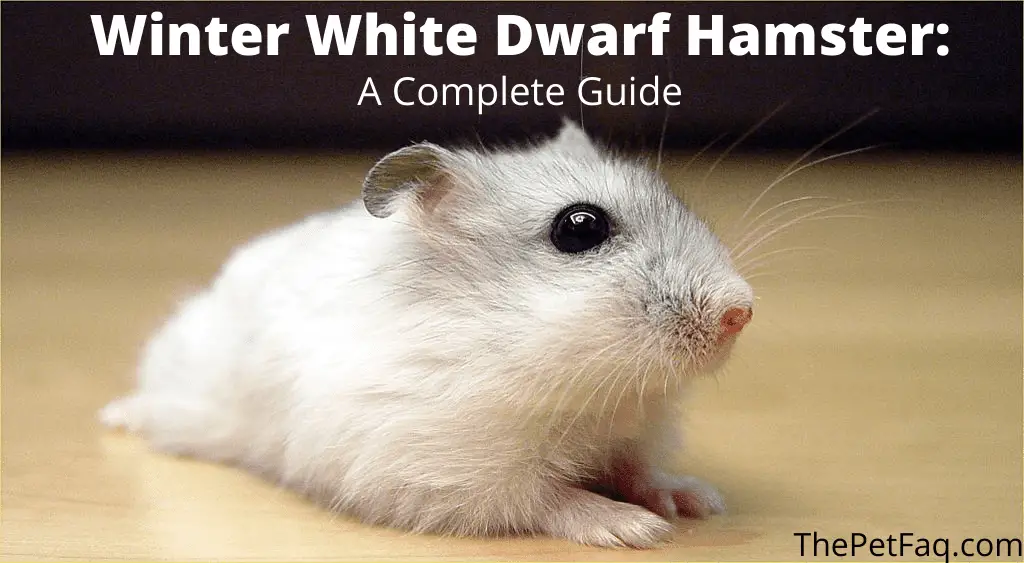
Today, we’re going to put this little fella under the microscope. We’re taking a look at where they come from, what they look like, their temperament, how to care for them, and much more. Let’s get into it!
Winter White Hamster Fact Sheet
| Name(s) | Winter white dwarf hamster, Russian Dwarf Hamster, Djungarian hamster, striped dwarf hamster, the Siberian hamster |
| Size | 3 to 4 inches in length |
| Weight | 1 to 2 ounces |
| Experience level | Good for beginner as well as experienced hamster owners |
| Lifespan | 1 to 3 years |
| Temperament | Tameable, social, intelligent, docile |
| Color | White in the winter, grayish in the summer |
| Coat length | Short |
| Can live with others? | Sometimes, depends on the situation |
What is a Winter White Dwarf Hamster exactly?
The Winter White is a dwarf hamster native to Siberia in Russia, Mongolia, and Kazakhstan. They were first caught in those regions in 1968 and brought to a research institute in Germany. Since then, they’ve made their way to breeders, and onto the pet market. They rapidly grew in popularity and are now one of the most popular hamster breeds in Europe, Japan, and North America.
One of the most unique features of the breed is that they’re capable of changing the color of their fur depending on the season. In the winter, their coat is white (which is where they get their name from), while in the summer, their coat is ash-gray to dark brown. These color changes occur because it allows them to blend into the environment better, which helps them hide from predators.
Appearance
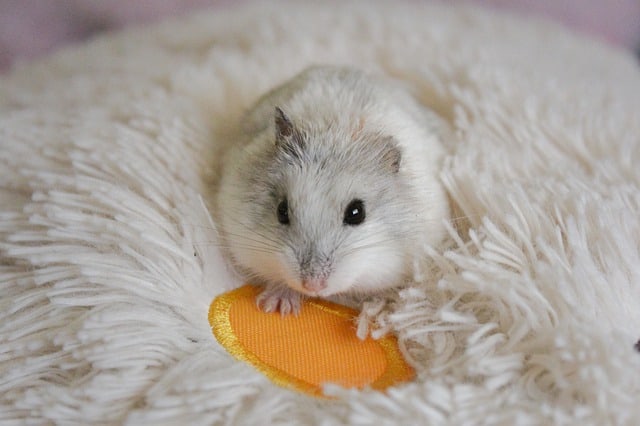
Winter White Dwarf Hamsters are very small, ball-shaped rodents. At about 3 to 4 inches long and 1 to 2 ounces in weight, they’re only about half the size of the larger Syrian hamster. These hamsters mature quickly, reaching adulthood and their maximum size at around 2 months of age.
Winter whites are usually an ash-gray or dark brown color in the summer, and white in the winter. Their underbellies are typically lighter in color and they have a dark dorsal stripe that runs along their spine.
While they’re often an ashy/grayish color, due to selective breeding, and because it’s possible to breed winter whites with Campbell’s hamsters, they can sometimes have different colorations as well.
Temperament of the Winter White Hamster
Winter white dwarf hamsters are typically docile and respond well to humans handling them. They’re usually not aggressive and do not bite often. However, since they’re small prey animals they can be scared quite easily. If they’re scared they can bite sometimes. To prevent this, make sure that you handle them gently and carefully.
You should also be careful when handling them because they’re very quick and nimble. Make sure that you handle them close to the ground so that if you do accidentally drop them they won’t fall from great heights.
Furthermore, winter white hamsters are quite easy to tame. They respond well to positive reinforcement in the form of treats and can become docile easier than some other hamster breeds.
Additionally, unlike the Syrian hamster, Winter Whites are more receptive to living together with other hamsters. It is sometimes possible to keep multiple winter white hamsters in the same cage. However, this often only works if the hamsters grew up together. Placing two adults in the same cage often results in territorial behavior and fights. If this happens, it’s essential that they’re separated immediately.
Also, it’s important to make sure that if you do keep two or more hamsters in the same cage that they’re the same sex, otherwise, they’ll start breeding and you’ll end up with a lot of hamster babies!
Caring for Winter White Hamsters
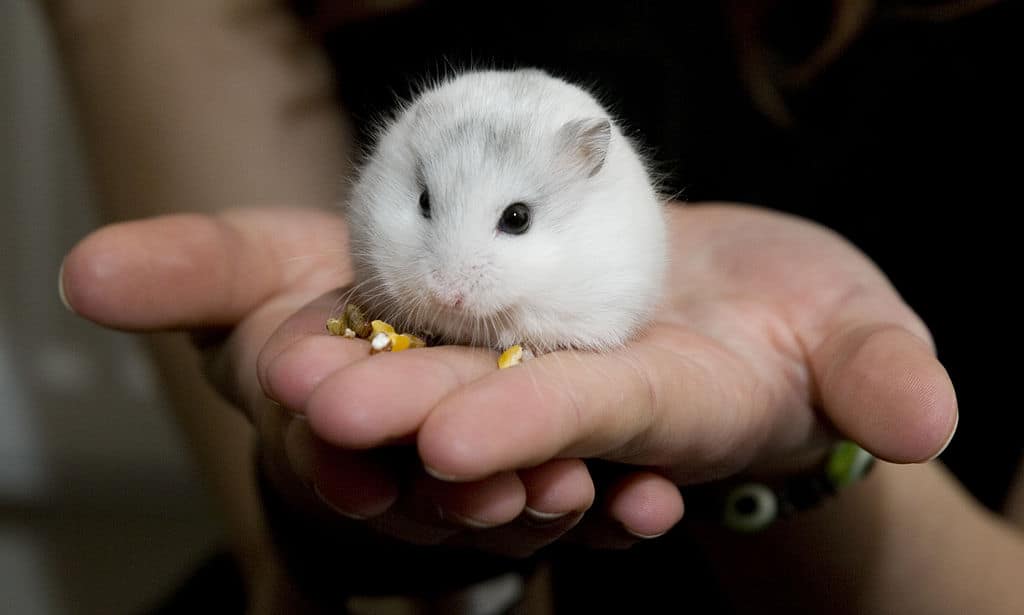
Winter White Dwarf hamsters are great pets for experienced as well as beginner pet owners. They’re relatively low-maintenance animals with simple dietary requirements and are easy to groom.
However, while taking care of Winter White hamsters isn’t very difficult, you do have to know what you’re doing. You have to know what they eat, how to house them, and how to groom them. Let’s take a closer look at each of these aspects in a little more detail.
Feeding Winter White Hamsters 🥦
Like all hamsters, the Winter White Dwarf hamster is an omnivore. This means that they can benefit from eating meat and insects as well as fruits and vegetables. However, while hamsters aren’t particularly picky eaters, it’s important that you feed them a diet that gives them all the nutrients they need.
The optimal diet for a Winter White hamster consists of about 80 to 90% of pellets. These commercial pellets should be the cornerstone of your hamster’s diet because they’re the most nutritionally complete food available to them. They’re specially formulated to contain the majority of what your hamster needs. They need about a spoonful of these pellets per day.
Some people opt to feed seed mixes instead of pellets, but this is far from ideal. Pellets are far more nutritious than seeds. In addition, hamsters are often picky when you give them a seed mix, eating only their favorite seeds and discarding the rest. Pellets really are the superior food option for them.
The remaining 10 to 20% of their diet should consist primarily of fresh fruits and vegetables. You can also give them an occasional piece of meat, fish, nut, or hard-boiled egg as a treat.
Some foods that these hamsters enjoy eating include:
- Vegetables: Broccoli, Bell Peppers, peas, spinach, squash, kale, carrots
- Fruits: Apples (without the seeds), pears, banana, blackberry, blueberry, cherry
- Meats & fish: Salmon, chicken, turkey
- Others: Sunflower seeds, walnuts, hard-boiled egg
As far as drinking goes, make sure that your winter white always has access to clean water. They should not drink anything else except for water!
Housing a Winter White Dwarf Hamster 🏡
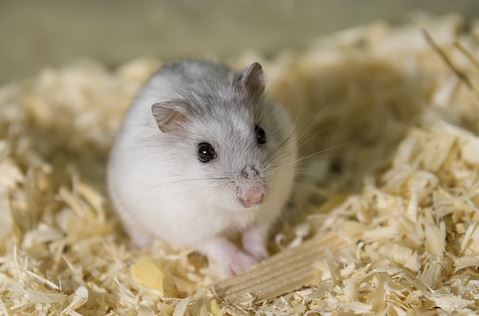
Most hamsters spend the majority of their lives in their cage so it’s important that they have a comfortable cage that’s adequate in size.
The minimum cage size for a winter white dwarf hamster is 24 inches long and 12 inches wide. Do keep in mind that this is a minimum, a bigger cage is always better. If you can afford a bigger cage and have the space for it, definitely go for it, your hamster will thank you for it.
Also, if you’re keeping more than one of these hamsters in the same cage make sure that you increase the size of their cage accordingly.
Hamsters do well in wire cages with a plastic bottom. These cages can be bought in many pet shops or online. An important factor to keep into consideration when buying a cage is bar spacing. Dwarf hamsters are very small so the space between the bars needs to be small enough to prevent escape. Make sure that the bar spacing is no more than ¼ inch.
Some hamster owners also choose to house Winter Whites in a tank. This is an option but not ideal because they’re less well ventilated.
Bedding
You of course want your winter white hamster to be comfortable in its new home, so you’ll need bedding. If you’re buying wood-based bedding, go for aspen, avoid cedar or pine shavings. Pine and cedar might smell nice to us humans, but they can cause irritation to your hamster.
Cloth or paper-based beddings such as Kaytee Clean & Cozy are also a great option.
Once you’ve got the bedding, put it in the cage in a layer of about 4 inches deep.
Cage essentials
Besides bedding, there are some other cage essentials you’ll need to make your hamster feel at home. An empty cage is quite boring, so make sure that you at least get the following components:
- Exercise wheel
- Food dish and water bottle
- Houses or huts
- Chew toys
Decorating the cage is a lot of fun and you have a lot of freedom in doing it, as long as the essentials above are met, you can go as crazy as you want when decorating their cage.
If you want to let your hamster run around the house, a hamster ball is also a good idea.
Grooming ✂️
Winter white dwarf hamsters are very clean animals. They hate being dirty so they spend a lot of time grooming themselves to ensure that they’re always clean.
Because they’re so good at grooming themselves they do not need baths or any other grooming. If you notice that they’re getting a little dirty all you have to do is pat them down with a damp cloth to remove the dirt but this should not be necessary very often.
To aid your hamster in their grooming you can buy a sand bath. Sand baths are great ways for hamsters to keep themselves clean. Additionally, a good way to help your hamster stay clean in making sure that you keep their cage fresh. Thoroughly clean their habitat at least once per two weeks to prevent odors.
Lifespan & Health
Winter white dwarf hamsters are a robust breed. They do not get sick very often and are generally quite resilient. However, there are a few ailments that all hamsters suffer from.
- Wet tail. Wet tail is pretty much hamster diarrhea. It’s caused by bacteria that results in watery diarrhea and a lack of appetite in your hamster. If you notice these symptoms in your hamster, it’s important that you bring them to a vet right away. Wet tail can be treated with antibiotics by a veterinarian but it has to happen quickly because it can be lethal.
- Overgrown teeth. Hamsters are rodents. As such, their teeth never stop growing. They grind their teeth down by chewing on things. Make sure that they always have access to plenty of chew toys that they can use to keep the size of their teeth in check.
When kept in good conditions and fed a high-quality diet the average Winter White hamster lives for an average of 1 to 3 years.
This is quite short, and that might be a downside for some people who want to spend longer with their pet. If 1 to 3 years is too short, I recommend looking into getting a guinea pig instead. Guinea pigs can live for up to 8 years, so you’ll have a much longer time with them.
On the other hand, for some people getting a pet with a shorter lifespan can be a benefit because it’s less of a long-term commitment.
Taming a winter white hamster
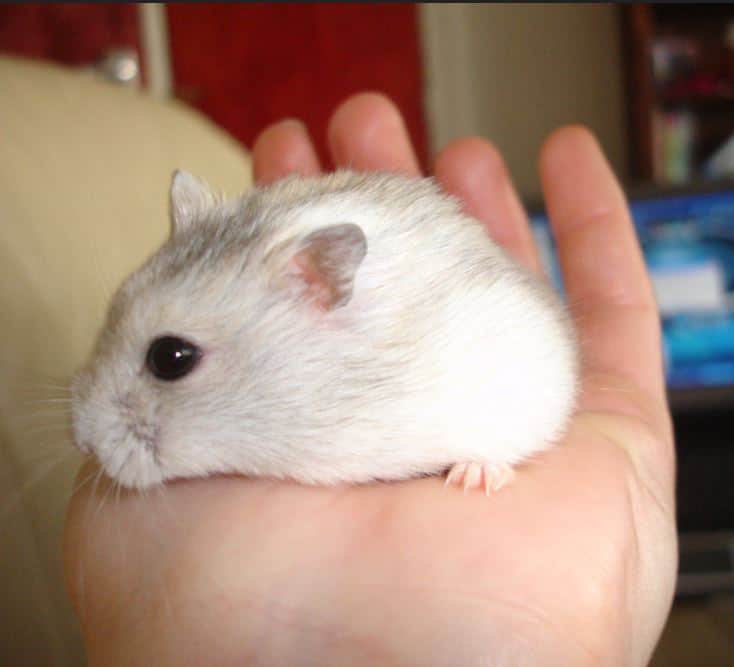
Compared to other dwarf hamsters, such as the Roborovksi and the Chinese hamster, winter whites are quite easy to tame. They’re typically less skittish and shy, as well as more receptive to humans.
When you first bring your Winter White Dwarf Hamster home it’s important that you do not immediately pick them up. Give them some time to acclimate to their new home and get used to all the new smells and sounds. For the first few days, just let them stay in their cage and let them get used to being in your presence.
After the first few days, start by putting your hand in their cage. Winter whites are quite curious animals and they’ll most likely come to your hand to investigate it. They’ll most likely sniff your hand. At this point, you can also offer them a treat from your hand. This will let your hamster associate the good feelings it gets from the treat with your presence, and it will start to form a bond with you.
After that, you can start petting them and slowly work your way towards picking them up. Always do this slowly so that you do not startle them. When handling them, make sure that you do not drop them or let them escape. Once they escape they can be quite difficult to find!
Buying a Winter White Hamster
Winter white hamsters are very cheap animals, making them available to a wide range of people. The recommended way to get your hands on one of these adorable animals is by buying them from a breeder. Ethical, reputable breeders treat their hamsters much better than pet shops, which often get the animals they sell from rodent mills.
By buying from a breeder you not only support ethical breeding, but you’re also more likely to get a hamster that’s in good health and more socialized. The only benefit of buying from a pet shop is that it’s cheaper and more convenient.
On average, the price of buying a Winter White Dwarf Hamster from a good breeder is about $20 to $30.
Final words: Is the Winter White the breed for you?
The winter white is a hamster breed that falls between the Syrian and the other dwarf hamster breeds. They’re the most affectionate of the dwarf hamsters, but they do not always have the same territorial tendencies towards other hamsters that Syrians do.
If you’re looking for a dwarf hamster that’s easy to tame, energetic in nature, and a lot of fun to play with, the Winter White dwarf hamster might be ideal for you!
These hamsters are great for beginners as well as more experienced pet owners and are a popular choice for families with children.
- How Long Do American Eskimo Dogs Live? Important Factors and Care Tips - September 29, 2023
- Do American Bulldogs Need Grooming? Essential Tips and Care Guidelines - September 29, 2023
- Do Bengal Cats Enjoy Playing? Essential Tips for Keeping Them Active - September 29, 2023